
Starr Family Home State Historic Site is a 3.1-acre (1.3 ha) historical site operated by the Texas Historical Commission in downtown Marshall, Texas. It was listed on the National Register of Historic Places in 1979. The museum was made a Recorded Texas Historic Landmark in 1986. On January 1, 2008, the site was transferred from the Texas Parks and Wildlife Department to the Texas Historical Commission.

The Old Harrison County Courthouse is located in the center of Whetstone Square in Marshall, Texas and is one of the most famous and admired buildings in Texas. It is the signature landmark of Marshall and is frequently used to represent East Texas in travel literature.
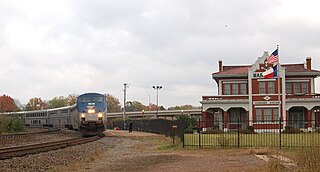
Marshall station is a railroad station in Marshall, Texas. It is served by Amtrak, the national railroad passenger system, which operates the Texas Eagle through Marshall each day, with service north to Chicago and west-southwest to Dallas, San Antonio and Los Angeles. The station also houses the Texas and Pacific Railway Depot & Museum.
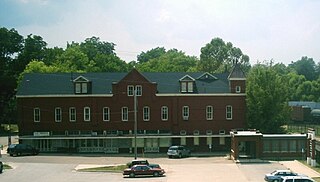
The Ginocchio or Ginocchio Hotel is a historic hotel in Marshall, Texas that was originally constructed in 1896 next to the Texas and Pacific Railway station. At that time, it was on the same side of the tracks and provided disembarking passengers with ready access to a hotel and restaurant facility. During its height, the building housed several U.S. Presidents and actor John Barrymore, among others. The name is derived from the family that built the building and is located in the Ginocchio Historic District of the National Register of Historic Places. In 2017, the establishment reopened under new ownership as a restaurant and bar after being closed for renovations for two years.

The Texas Historical Commission is an agency dedicated to historic preservation within the U.S. state of Texas. It administers the National Register of Historic Places for sites in Texas.
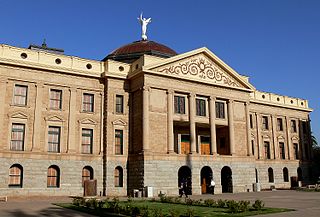
James Riely Gordon was an architect who practiced in San Antonio until 1902 and then in New York City, where he gained national recognition. J. Riely Gordon is best known for his landmark county courthouses, in particular those in Texas. Working during the state's "Golden Age" (1883–1898) of courthouse construction, Gordon saw 18 of his designs erected from 1885 to 1901; today, 12 remain.

This is a list of the National Register of Historic Places listings in Bexar County, Texas.
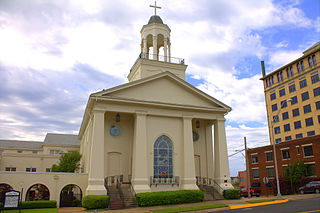
First Methodist Church is a historic Methodist church at 300 E. Houston Street in Marshall, Texas. It has also been known as First United Methodist Church and as Methodist Episcopal Church of South Marshall. It is a stuccoed brick Greek Revival-style church with a portico having four monumental square columns; such architecture is rare in Texas.

The Bandera County Courthouse and Jail are two separate historic county governmental buildings located near each other in Bandera, Bandera County, Texas, The Bandera County Courthouse, built in 1890 at the corner of Main and Pecan streets, is a Renaissance Revival style building designed by San Antonio architect B. F. Trester. It is three-story building with a central clock tower made from rusticated limestone cut from a local quarry. The clock is non-functioning and painted on, displaying the time 10:09. The current jail is a non-historic, modern facility located along State Highway 16 on the north end of town.

The architectural structures of Fredericksburg, Texas are often unique to the Texas Hill Country, and are historical edifices of the German immigrants who settled the area in the 19th Century. Many of the structures have historic designations on a state or national level. The Gillespie County Historical Society is actively involved in assisting with preservation.

The Llano County Courthouse and Jail were erected separately, but added to the National Register of Historic Places in Texas on December 2, 1977 as one entry. The courthouse, located in the middle of Llano's historic square, was built in 1893. The exterior is made of sandstone, marble, and granite. The interior of the courthouse was damaged by fire in 1932 and again in 1951. It is still in use today by local government. The jail was erected in 1895, with the prisoner cells on the second and third floors, and the ground level solely for the office and living accommodations for the sheriff and his family. The jail was designated a Recorded Texas Historic Landmark 1979, Marker 9448. The courthouse was designated a Recorded Texas Historic Landmark 1980, Marker number 9446.

The Milam County Courthouse and Jail are two separate historic county governmental buildings located diagonally opposite each other in Cameron, Milam County, Texas. The Milam County Courthouse, located at 100 South Fannin Avenue, was built in 1890–1892, while the Milam County Jail, now known as the Milam County Museum, was built in 1895. On December 20, 1977, they were added to the National Register of Historic Places as a single entry.

The John M. and Lottie D. Moore House is at 406 S. Fifth Street, in Richmond, Texas, United States. It is currently part of the Fort Bend Museum complex. It was added to the National Register of Historic Places listings in Fort Bend County, Texas in 2001, and became a Recorded Texas Historic Landmark in 1962.

The William J. Bryce House, known as Fairview, is located on 4900 Bryce Avenue in Fort Worth, in the U.S. state of Texas.

The Hudspeth County Courthouse is located in the town of Sierra Blanca, the seat of Hudspeth County in the U.S. state of Texas. The courthouse was constructed in 1919 and added to the National Register of Historic Places in 1975. The Texas Historical Commission (THC) has also designated the building as a Recorded Texas Historic Landmark since 1962 and as a State Antiquities Landmark since 1981. The county is named for Claude Benton Hudspeth who served as a U.S. representative from El Paso and previously in both houses of the Texas Legislature where, as a member of the Texas Senate, he was influential in the county's creation.

The Arnot House is a raised one-story house located at 306 W. Houston Street in Marshall, Texas. Built in 1848, it is one of the oldest houses in Marshall. An early Greek Revival style building, it is also described as a "classic Creole, or Louisiana raised-cottage, rendered in the Greek Revival style." It is made of wood frame on load-bearing brick basement/ground floor walls, with "Marshall Brown" brick laid in common bond. The front porch, which is covered by the house's gable roof, "is articulated with stout square columns, placing the house in the early phase of Greek Revival."

The Hagerty House, also called the Hagerty-Harris House, is a two-story house located on 505 East Rusk Street in Marshall, Texas. Built in 1889 by Thomas Higgins, it was the first solid brick residence in Marshall. It was built for William Phillip Hagerty, personal engineer of Texas and Pacific Railroad president George J. Gould by railway craftsmen. Born in 1848 in Ireland during the Great Famine, Hagerty was likely to be arrested by the British government due to his nationalist activities when he emigrated in 1866 to the United States.
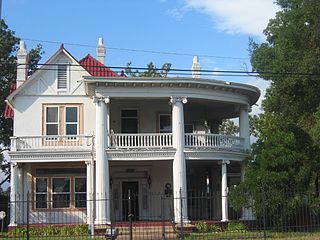
The Hochwald House is a Victorian 2+1⁄2-story house on 211 West Grand Avenue in Marshall, Texas. Built 1894 to 1895, the house was named after Isaac Hochwald (1865-1956), a prominent Jewish merchant. In 1912, the house was renovated to include classical revival features. Hochwald, who built the house with his wife Amelia Raphel Hochwald, lived in the house until 1956.
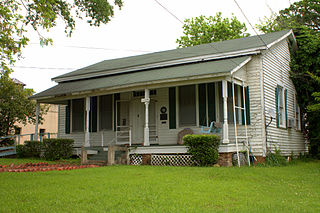
The James Turner House, a one-story Greek Revival style building located on 406 North Washington Avenue in Marshall, Texas, was built by a merchant, George Gammon Gregg to be the home for him and his bride, Mary Ann Wilson, who were married in 1851. It was first located at the southeast corner of Crockett Street and Washington Avenue.
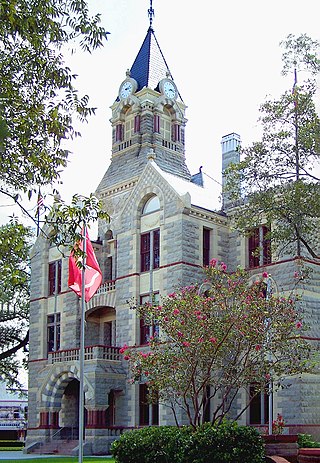
The Fayette County Courthouse and the Fayette County Jail are two historic buildings in La Grange, Texas. The courthouse was designed by James Riely Gordon and built in 1891 by Martin, Byrne and Johnston. The jail was built earlier in 1881 by Fritz Schulte and designed by John Andrewartha and James Wahrenberger. Both buildings were added to the National Register of Historic Places (NRHP) as a single listing on January 23, 1975. and designated a Texas State Antiquities Landmark on January 1, 1981 by the Texas Historical Commission (THC). Texas historical marker number 12627 erected in 2001 commemorates the courthouse's status as a Recorded Texas Historic Landmark, marker no. 18757 placed in 2017 does likewise for the jail. On January 16, 2001 both buildings were designated and recorded in the NRHP as contributing properties to the Fayette County Courthouse Square Historic District.
























